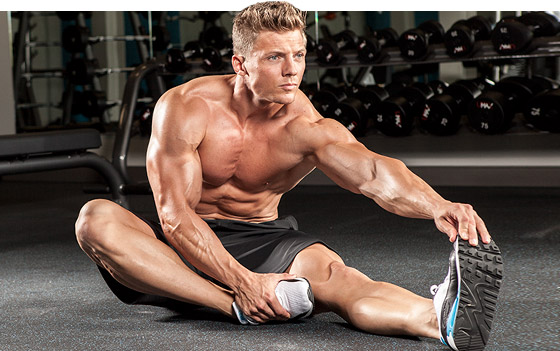Articles
FIRST TIME HERE?
READ THIS ARTICLES FIRST
If Superman did a running workout, this would be it.
It’s the #1 method for packing on lean muscle and cutting inches off your waist in the shortest amount of time. While also skyrocketing your testosterone and growth hormone levels. Most ordinary folks know nothing about it…
Listen up. Not all running is created equal. And the most efficientOlympic athletes and buffest Hollywood actors and fitness models know this…
Now, there’s always traditional high intensity interval training…
However, you can screw HIIT up quite a bit. And you’ll leave tons of muscle building results on the table because of it…
So instead of spinning your wheels, feeling like a lab rat trapped in a cage… Combine the below techniques to your running workouts for superhuman results…
Anabolic Cardio Workout For Massive Muscle Gains
Just imagine having eye-popping vascularity. With veins the size of pythons hanging off your arms.
And a massive 530% boost in growth hormone for greater muscle gains and accelerated fat loss… with a ramped-up sex-drive so you can perform like superman in the sack…
All because you’ve adopted an anabolic cardio philosophy…well, it’s possible man. Yet there’s some bad high intensity interval training habits you have to break first.
Because…
Most “Traditional” Interval Training Workouts Won’t Give You The Results You Crave.
Here’s why…
Traditional interval training workouts typically last 6-10 seconds per interval. Although, this isn’t a bad thing… it’s not ideal if you want maximal results.
A recent study published in the British Journal of Sports Medicineshows lactic acid is the #1 factor for achieving an exercise induced growth-hormone response (1).
Which is vital for muscle-growth.
Yet traditional 6-10 second sprint interval workouts don’t last long enough to reach the lactic threshold… a.k.a. the secret sauce of muscle building cardio…
Not until 15 to 20 seconds of all-out sprint effort does your body begin producing muscle-building lactic acid… yet most guys never reach that point in their training.
Unlike common thought, the first 10 seconds of a sprint are aerobic (with oxygen). Not anaerobic (without oxygen)…. this according to the author of The Oxygen Advantage and Buteyko Breathing expert, Patrick McKeown…
(Buteyko breathing is crucial for your gains… I’ll reveal why in a moment)…
Back to oxygen. As long as it’s present during exercise, it’s impossible to reach the coveted lactic threshold responsible for turning your cardio workout into a muscle-building matrix.
To make a long story short… your Sprint Interval Workout should last 20-30 seconds for max gains.
Word of warning: It’s going to hurt. Your lungs will feel on fire. Your legs and arms will weigh heavy like cement. And the last 10 seconds of each sprint will test your mental grit.
Yet because you’re on my site, I know you’re a guy who’s serious about making gains… and you’ll trade a little pain for the glory of a ripped, attention-grabbing physique that would grace the Hollywood big-screen in the next superhero flick…
Am I right?
Buteyko Breathing For Nitric Oxide Gains
Here’s another trick you’ll want to add to your sprint training workout if you’re determined to get the best results from your cardio regimen and become an anabolic animal…
Have you heard of Buteyko breathing? Probs not. Most guys haven’t. It’s a special breathing technique developed by a Soviet Union scientist in the 1960’s…
And when used during sprinting you’ll experience tons of anabolic benefits… one being, a massive surge in nitric oxide production (2)…
Here’s why that rocks.
Nitric oxide is the infamous “Viagra chemical” that helps guys last longer and perform stronger in bed. Yet instead of becoming a slave to the little-blue pill… and selling your soul to Big Pharma and their nasty side-effects, this one breathing hack may do the trick…
And there’s plenty more benefits to the increase in natural nitric oxide levels…
Like improved cardiovascular health, lowered blood pressure, bigger muscle pumps, and greater nutrient delivery to your muscles for faster recovery.
Here’s the trick.
How To Turn Traditional HIIT Into Anabolic Running
Combine the simple Buteyko nasal breathing method to your sprint while in the lactic threshold during your sprint interval workout and your natural nitric oxide levels will shoot through the roof (3)…
It may feel strange at first. But you’ll get used to it. And I guarantee you’ll never perform your cardio workouts without this technique moving forward. It’s that powerful and the results are that noticeable…
In fact, with only 16-minutes per week following an anabolic cardio workout like this and you’ll trigger better results than what most people spend hours chasing in the gym…
I’ve been there. I used to follow traditional cardio methods. Which destroyed my sex drive, stripped me of my hard-earned muscle mass, and nearly ruined my marriage…
Yep, my marriage. It’s embarrassing to admit, and you can read more about my story here…
What I’ve learned is your cardio workouts can be your greatest muscle-building, testosterone boosting ally… or it can steal your gains, make you more fat, and send your male-libido on life support…
Question is… what’s it gonna be for you? To be honest, Anabolic Running is only for guys who don’t want to go through the motions anymore…
What To Do Next…
For guys who want the MOST out of their workouts and aren’t willing to leave any results on the table… If that’s you, here’s your next action step:
Add Anabolic Running to the beginning of any workout, or perform on your days off from strength training and you’ll be on the fast track to a lean and rock-hard body that subconsciously demands respect from other men and attracts the opposite sex…
Just like a superhero… They’ve got the brawn. The respect. The lady. And the power. You can too.
These Anabolic Running workouts take as little as 4-minutes per workout. That’s it. And you don’t have to necessarily “run” to experience the results…
Just follow the Anabolic Running principles while on a stationary bike, elliptical, ergometer, etc… and watch your body transform into a lean and muscular physique.
Now’s your chance to harness the power of Anabolic Running:
Click Here to Access The Anabolic Running Program
References:
1. The Role of Lactate in the Exercise Induced Human Growth Hormone Response: Evidence From McArdle Disease. Centre For Sports Medicine & Human Performance. Brunel University, Uxbridge. Godfrey, Richard. 2009, July.
2. Mercola, Joseph. “Buteyko Breathing Method Helps Reverse Health Problems.”Mercola.com. N.p., 24 Nov. 2014. Web. 08 July 2017.
3. McKeown, Patrick. The Oxygen Advantage: The Simple, Scientifically Proven Breathing Techniques For A Healthier, Slimmer, Faster and Fitter You.
Do you even lift bro?
I thought so, but how do you prove it.
The average lifter usually judges you on your lift. Yes- just one lift- the bench press.
It just looks so badass seeing the most jacked guy in the gym burying himself under a mountain of iron and pumping it down to his chest and back up again.
And even personally, I cannot even count the amount of times I’ve received the “Hey, how much can you bench, man?” question.
Over time we grow bigger, stronger, and a bit older and wiser in the process, showed me that the flat bench isn’t all that.
In fact, the flat bench may be KILLING your progress in the gym.
Here are 3 reasons you need to ditch using the flat bench for good today.
#1 You Want Muscle- Not Man-Boobs
Ever see a big muscular guy pop his shirt off only have have big saggy pecs?
That guy may even be you! See, all that effort pushing the pace and killing it in the gym might not be helping your body. This happens despite getting a solid night of sleep regularly and eating the cleanest foods with plenty of protein and veggies.
It drives most guys crazy to not figure this out sooner. The secret is your biomechanics. Here’s what I mean…
When you use a flat bench you develop the muscle and make it larger. That’s kind of the idea of exercise, so that should make sense. However, it isn’t that simple.
You see, new research is showing that muscles are composed of different units. For example, you can split your chest into an upper unit and a lower unit. While flat bench can work the lower region it doesn’t efficiently work the upper part. The result?
Your chest muscles get larger but they sag when you stand because the top muscles aren’t developed as much as they can be.
The solution is simple. You want to skip the flat bench and go right into an incline bench. With different leverage on your muscles, you’ll work the chest here with a greater emphasis on the upper chest to give you those ideal pecs that are strong AND catch attention at the beach.
#2 You Don’t Want to Turn Into A Plank
Generating stability and pressing for a heavy bench press may build your chest and get you stronger…
But it may be destroying your mobility.
You’ll notice in the tiny aspects of your life that while you feel stronger and put up bigger numbers on your flat bench, it’s tougher to tie your shoes or put on shirts. Even your walk is more mechanical and still.
It literally looks as if you have a stick shoved somewhere unpleasant, right?
That’s because when you set up for the bench press your shoulders are pinned under all that weight. This means, you’re placing a heavy load on your body and pinning your scapula and spine down.
Without working on your mobility, this shoulder tightness simply spreads making you stiffer and stiffer, possibly leading to injury.
Another alternative is skipping the flat bench and working the chest in a similar way with cables or with bodyweight pushing exercises. You can get massive strength (and bring out your 6-pack abs) with the stability demands of cable pressing or working towards a 1-arm pushup.
#3 You don’t want excess elbow and shoulder stress
Bench pressing can put a ton of stress on your wrists, elbows, and shoulders if you’re not used to it. Unfortunately, the joint strength comes largely from the condition of your tendons and ligaments. There take much longer than muscles to respond to training loads and grow stronger.
This means that if you’re pushing your strength and muscles on the bench press you may be overtraining these vital connective tissues!
That being said, the flat bench is a surprisingly technical lift- it isn’t just lay down and push.
You need to have your arms the proper distance apart (based on your arm length), you need traction from the floor, your shoulders back and down, ribcage slightly lifted, torque generated in your shoulders, and traction from the floor.
Whew, that’s a lot!
And if you’re off a bit it could mean more strain down the road because your elbows, shoulders, or wrists will have to make up for the slack.
A good alternative is to use dumbbell presses.
Here, you don’t have a rigid barbell so you can more easily rotate and align your body for optimal pushing. The extra stability challenge means that you can use LESS weight but still build REAL strength.
At the end of the day, the flat bench press isn’t going anywhere. It’s a classic test of strength. But maybe, it should remain a test and not a normal part of your training. Unless you want to get really good at the flat bench press, you really don’t need to practice it all the time.
Instead, use the substitutions in the article above and you won’t even miss the flat bench press.
You’ll be able to build more functional strength with increased shoulder and core stabilization.
You’ll be able to improve the look of your pecs so no one mistakes your chest muscles for man boobs after all your hours in and out of the gym.
You’ll even save your joints tremendous strain by preventing pain in your elbows, shoulders, and wrists.
Not to mention, you’ll save time at the gym by not having to wait for EVERYONE to use the flat bench.
Try these variations this week and enjoy your results.
Is your training moving you closer to your goals or are you just killing time in the gym?
You see, 92% of the guys out there snag an average routine from offline or from a magazine to get into average shape. Guys like you follow the same plan for months before realizing it’s not getting them the results they want.
The truth is they either get injured OR discouraged from seeing no results and stop lifting.
It’s a painful pattern especially since lifting isn’t hard. Getting fit gives you three key things; strength, muscles, and makes you harder to kill.
Pass all 8 of these tests and you’ll know you’ve become one big strong badass.
Can You Bench Enough?
It seems the first question a novice asks is the same old, “how much do you bench”.
It’s about the same as giving someone a passing “how are you”.
While most guys go through the motion of the bench press in hopes of gaining monstrous strength and looking ripped, few achieve those goals.
So, let’s separate those boys from us men.
If you can bench press your bodyweight you’ve officially passed a tremendous milestone, which makes it our first badass test.
Not there yet? No problem! This usually comes down to two sticking points; either your technique or distractions.
For your technique, you want to place your wrists above your elbows to stack the joints on top of each other. This means you’ll have to widen up your grip a bit
For distractions, you want to quit killing your muscles with all that extra nonsense in your routine. That means if you bench, incline bench, do chest flys, and other chest exercises you won’t be developing that badass bench pressing strength.
Stay focused and you’ll knock this one out of the park.
But the truth is that the bench press isn’t that special…
..how much do you front squat? Clean?
I think you get it, for big compound lifts you know you’re a badass when you can rep out ATLEAST your bodyweight.
Join the Double Bodyweight Deadlift Club.
The deadlift checks out your ability to produce tension, grip strength, and fire your ‘go’ muscles that are used in everything from mind-blowing sex to walking up stairs.
You don’t need a 505 pound deadlift, but pulling double your bodyweight means you’re ready for whatever lift has to throw at you. It could be that you avoid pain carrying the groceries into the house or you may save a friend’s life by picking him off the floor and taking him to the emergency room.
The best part is getting a better deadlifting just requires you be strong. So, work your grip with pullups, work your hips with kettlebells, and work your tension with high rep squats. This guarantees a flexible training approach that avoids boredom or burnout.
The 2-Minute Plank Meltdown.
Let’s be honest. It feels challenging to push or lift a heavy weight, but once it’s lifted you’re done, right?
Unfortunately, we can’t label you as a badass without proof of some endurance. Here, the test of endurance is all about your core strength.
We’re talking functionality, posture, strength, endurance, and the mental toughness to sweat out a two minute plank.
If you can squat or deadlift big numbers this will be a walk in the park for you because all three moves require abdominal tension.
And by tension we aren’t talking about floating in this position like a hippie, we mean actively flexing with the lats, glutes, and core engaged so you’re actively working here.
Look Ma- No Hands!
Remember those commercials?
“I’ve fallen and I can’t get up”
Here’s a crazy fact: the average man in the United States is too weak to do a single pushup. This means when they fall down they cannot get up.
Can you imagine struggling to crazy to a phone because you’ve fallen and don’t have the strength to get back up?
This test doesn’t focus on the push up. If you’re reading this you are NOT the average guy. I challenge you to take getting up off the floor to the next level and lift yourself up using only your feet.
That’s right, from laying down to standing without using your hands.
The easiest way is to sit up, get your legs underneath you, and get into a lunge position and step up.
If you want to get fancier you can teach yourself to kip up like Bruce Lee!
Balance On One Foot For 10 Seconds
More men fail this test than you’d believe.
Balancing is a sign of coordination. It’s where your strength meets your mobility. If you can’t balance on one foot for 10 seconds you’re infinitely more likely to have muscle imbalances, hip problems, and will likely fall down in the near future.
Plus, you can’t use the ultimate defense from the Karate Kid!
By focusing on balance your lifts WILL go up too. Better balance allows you to not fight the weights as much because you’re properly grounded in the lift and naturally in better alignment.
Do yourself a favor and invest 20 seconds on this one.
Too easy? You can step this test up by closing your eyes and shaking your head while you balance.
The Death Grip Test
How healthy are your shoulders?
Apparently, we’ve evolved from climbers. Whether it was snagging fruit from a tree or scaling a cliff to run from a lion, you and I were meant to climb.
However, men who hang from branches, or even pull up bars, are a rare sight. You can even see it in the “forward head” posture that most guys have because they completely skip hanging movements and have poor posture, weak shoulders, and lead mediocre lives.
But not you.
You’re a badass, right?
That’s why we’re going to hang. This test has several stages:
First, you just want to actively hang for 30 seconds. By actively hanging I’m talking about shoulder blades drawn back and down, like you’re trying to pinch a dollar between your scapula, and a slight bend in the elbows.
Got it?
Next, after 30 seconds, do a pullup.
If that’s all you can do, it’s a start. Otherwise, you can repeat the cycle of 30 second hang and one pull up for 9 more times and see how far you get.
If you can do that you’re probably set for ninja warrior with strong healthy shoulders with a killer grip.
The Leap
What is the point of having a big squat or deadlift if you can’t use it for anything?
The long jump teaches you to use all that strength quickly and powerfully. Meaning you can sprint faster, jump farther, and kick harder.
With the long jump it’s mostly about dialing in your form to get proper distance and being strong. The key is to not bend your knees too much.
Simply throw your arms back as you go down to a quarter squat (this preloads your leg muscles like a stretched rubber band) then fling your arms forward as you explode from your hips- just like a power clean.
Hips, knees, ankles all extending as your arms reach out and you soar.
Cardio For The Modern Badass
If the deadlift and the plank had a baby it would be the Farmer’s Walk.
Sure, you can lift weights all you like BUT can you walk with them? Try this test and you’ll find out. Take a deep breath and pick up half your bodyweight in each hand and go for a walk, the farther the better.
Just do yourself a favor and end your walk near the weight racks- you’re welcome in advance.
If you ace this, not only can you hold onto a decent amount of weight but you’re proving you can walk and stabilize the weight without falling and getting hurt. Your forearms will burn, your lungs will beg for more air, and you’ll want to take a break- don’t you’ve got this.
At the end of the day there are many different reasons to train. If you’re looking to be stronger, harder to kill, and be useful in a crisis to friends and family these are the test you need to pass.
I challenge you to try at least one tomorrow and see how you stack up.
There I was, doing pushups in my bedroom. Twenty pushups per set, if memory serves me.
Not that I couldn’t do more, of course. I could easily have done more than fifty pushups per set- and I wanted to.
I knew I could have pushed myself a lot harder- hell, I could have been in the gym lifting daddy weights instead of at home doing pushups. But I remembered the times when I had pushed myself too hard, trained too much and too often. I remembered the injuries, the sleepless nights, the depression and apathy.
And so that’s why I was taking a deload week. In fact, I wasn’t even supposed to be doing the pushups, but I couldn’t quite bring myself to not work out for a whole week.
I figured there had to be a better way- some way that I could push myself as hard as I wanted to, and avoid overtraining, without needing to take a week off every two months.
And there is. But first, let’s take a step back and look at why most programs incorporate de-loads.
Suppose you’re a trainer designing one of these programs. You want the people following your program to progress as fast as possible.
However, you know that some trainees will push themselves harder than others. You know that some people can recover faster than others. So how do you design a one-size-fits-all program that will work for most of the people who follow it?
If a trainee’s workload is less than what his body could handle, his progress will be slower than it could be. Maybe he’ll make no progress at all, but in all likelihood he’ll make progress- it will just be slow.
On the other hand, if you dial up the volume and intensity too high, many of the people who follow your program will develop overtraining syndrome. Their gainz will plateau and even start to reverse, they’ll be fatigued, depressed and sick all the time, and their dicks might even stop working.
Faced with this choice, under-training is clearly the lesser of two evils. And indeed, most programs err on the side of creating too little training stimulus rather than too much. Most dedicated trainees will be satisfied with any progress at all, even glacially slow progress.
But what if there was a better way? What if you could push your body to its limits- without ever going over?
Auto-regulation: The secret to making faster gainz, without overtraining
Auto-regulation is a set of techniques used to dynamically adjust the volume and intensity of your workouts. Properly employed, they allow you to build strength, work capacity and muscle mass as fast as physiologically possible.
In other words, auto-regulation is fucking awesome. But let’s be clear on what it is and is not.
There have been time when I worked out harder than planned, because I felt like my body could take it. There have also been times when I cut my workouts short, or used lighter weights than planned, because I felt more fatigued than expected and didn’t want to over-exert myself.
That can be useful, but it’s not auto-regulation.
Auto-regulation is more than just “listening to your body.” Rather than acting on subjective feelings, it’s characterized by the use of specific, objective, and pre-planned rules for adjusting your fitness programming on the fly.
Auto-regulation techniques come in a few varieties. Here’s a basic typology:
Positive techniques increase the training stimulus when possible, while negative techniques decrease the training stimulus when necessary.
Single-exercise techniques modulate the training stimulus applied with a single exercise, while whole-body techniques modify the training load applied to your whole body, usually by adding or subtracting rest days.
Finally, dietary auto-regulation adjusts your diet, adding or subtracting calories in order to either maximize hypertrophy without fat gain, or maximize fat loss without losing strength or muscle mass.
I know what you’re thinking- Cool story bro, but how do I use it? I gotcha. Here are for auto-regulation techniques you can start incorporating today.
Technique #1: Reactive deloading
One of the more commonly used methods of auto-regulation, reactive deloading is a single-exercise negative technique. Out of all the auto-regulation techniques, this is the one that most directly substitutes for traditional deloads.
Here’s how it works: when you fail to hit the expected number of reps on one of your sets, you lower the weight by about 20% for all remaining sets of that same exercise. All remaining sets are performed at high speeds in order to reach high muscle activation levels, and are still limited to the same number of reps despite using a lower weight.
Example: you’re bench pressing 245 pounds for five sets of five, at a low, controlled cadence. On the second set you only make four reps. You lower the weight to 195 pounds and perform the remaining three sets as sets of five, lifting with an explosive tempo.
Note that the weight is only lowered for that one exercise, and only for the remainder of that one workout. Once you’re done with the last set, it’s back to your regularly scheduled program.
Reactive de-loading is best used with heavy, compound exercises that produce the most fatigue, and therefore present the greatest risk of overtraining. For lower-weight and isolation exercises, you’re better off either using AVT, which I’ll describe later, or not auto-regulating at all.
Technique #2: Autoregulatory volume training
Another negative, single body part technique, AVT has similar goals to reactive de-loading, but takes a different approach. Reactive deloading holds volume constant while allowing intensity to be lowered as needed. AVT takes the opposite approaching, holding the weight constant while allowing reps per set to free-float.
How it works is, you perform your first set of a given exercise as normal, carefully noting how hard you exerted yourself on the last rep. For subsequent sets, you use the same weight but instead of completing a target number of reps, you stop each set after doing a rep that was as difficult as the last rep of the first set.
This frees your mind from the need to count reps so that you can focus on moving the weight. Not thinking about reps lets you focus on your technique, and it tends to increase force production since you don’t hold back during the first few reps of each set.
Another way to look at this is that traditional weight training hold both volue and intensity constant from one workout to another, while difficulty varies. By contrast, both AVT and reactive deloading maintain consistent difficulty by allowing either the weight or volume to be adjusted as needed.
AVT is a great tool for normalizing the training stress produced by your workouts. It works best with exercises that are performed for at least five reps, but can be used with pretty much any exercise. The main determinant of whether to use it is your psychology.
This isn’t a good choice for unmotivated trainees who will use it as an excuse to slack off. On the other hand, it’s also a bad idea for people who can’t hold themselves back- those people will find themselves going to failure on the first set, then doing it again on every subsequent set.
In order to implement AVT, you need the discipline and determination to push yourself exactly as hard as planned- no more, no less.
Technique #3: Conditional failure training
Conditional failure training is a positive single-exercise technique, and in a sense it’s the polar opposite of reactive de-loading or AVT. Instead of lowering the workload when you fall short, you raise it when you meet or exceed expectations.
Here’s how it works: when you hit your expected number of reps on every set of a given exercise, you continue until muscle failure on the last set.
For instance, say you’re doing three sets of eight dumbbell shoulder presses. You make your eight reps on the first two sets, so when you hit eight reps on set three, you keep going, squeezing out two more reps before you can’t go any further.
Obviously, you only want to do this with exercises for which going to failure won’t be dangerous- nothing like military presses or back squats where you could drop the weight on yourself.
It works best with higher-rep exercises where you’re only reaching full muscle activation later in the set, and is best reserved for the last exercise in your workout that targets a given muscle. In other words, it works well with pec flyes, but not if you have dips coming up in a few minutes.
Technique #4: As-needed rest days
This one’s pretty self-explanatory; take an extra rest day when you need one. That makes this a negative, whole-body auto-regulation technique.
The catch, of course, is that you have clear rules for determining when you “need” an extra rest day. And of course, you have fewer pre-planned rest days, since the point here is to replace, not add to, your existing rest periods.
If you want to start doing this, first cut back on your planned rest days. If you’re currently working out every other day, switch to a two days on, one day off schedule. If you’re working out four days a week, raise that to five or six days a week.
You’ll want to take an extra rest day when you see signs of a whole body plateau. That means you’re falling short on multiple exercises across several body parts. Of course, we all have bad workouts sometimes due to normal day to day variation in strength and sleep quality, so you only want to throw in an extra rest day when this happens several times in a short period.
Example: You’ve been working out three days a week. You raise that to five days a week. On any given workout, if you fall short of your expected number of reps on three or more exercises, you mark that on your calendar as having been a bad workout.
If you have three bad workouts within a seven-day period, you add an extra rest day after that workout. You never take two rest days in a row however, so if this happens on the day before a rest day, you instead take your extra rest day on the day after the next workout.
While single body part methods like AVT and reactive de-loading are my first choice for negative auto-regulation, as-needed rest days make an effective second line of defense for people who are particularly prone to whole-body overtraining syndrome. I commonly recommend them for people who chronically under-eat, or who have irregular sleep schedules, whether due to insomnia, shift work, or frequent travel.
Your next steps
Any serious intermediate or advanced trainee can benefit from autoregulation. The first three techniques listed here can be added to any existing program without changing the workouts or overall schedule, so that’s where to start.
Pick three exercises in three different workouts you’re currently using. Apply reactive deloading, autoregulatory volume training, and conditional failure training to one exercise each, in accordance with the exercise selection guidelines I’ve laid out here.
Next time you change up your program, use each of those three methods on two exercises each. Additionally, raise your training frequency by one or two workouts per week, but start incorporating as-needed rest days into your schedule
By combining these four techniques, you can optimize your training load to the precise needs and capabilities of your body.
Auto-regulation is one of the many tools that elite coaches use to get their clients very big and very lean, without making them very, very exhausted. I’ve compiled twelve of these techniques in The Dirty Dozen: 12 Techniques for Greater Gainz, my free primer on advanced weight training methods.
By applying the right training method at the right time, in the right amount, you can optimize your workouts around whatever goal you want- whether that’s hypertrophy, strength, strength-endurance, fat loss or work capacity.
If you want to upgrade your body, you need to upgrade your knowledge.
Building muscle is just like anything else worth having in life…it takes time, discipline and consistency.
If you’re beginner, you don’t have to train like a professional bodybuilder.
Bodybuilders have that prized spot on the top of the muscle-bound hill. HOWEVER, their techniques may be too advanced to start with.
See, muscle building is simply a response to stress. You stress your muscles with weights and they come back bigger and stronger.
Now, the more you do this the bigger and stronger your muscles are and the harder it is to make further changes. This means bodybuilders must spend hours a day in the gym going to failure and doing crazy things that YOU don’t need to do. At least not yet.
So what do you need to do?
EAT
Eating is essential because what do you think muscle is made of?
There are no jacked elves that sneak into your room at night and make your muscles grow- it’s the FOOD you eat. If you do not eat enough your body won’t build muscle- period.
To start, focus on just eating MORE. Try eating 250 calories extra, above your resting metabolic rate, for two weeks and see how that goes. A simple trick to finding out your RMR is just multiple your weight (in pounds) by 15. So, if you’re 160 right now try eating around 2550 calories a day.
Note: This is just an estimate, the key here is to avoid eating too few calories. As a week or two passes you can adjust and see if you need more or less calories.
Focus
How many yachts can you water ski behind?
Just one baby.
If you’re looking to build mass then don’t plan to run a marathon or flaunt a 6-pack in the next few months. You body adapts to demands you impose upon it. If your goals stretch out in different directions you’ll end up drained, defeated, and where you are at right now.
Be a man, make a decision and make mass-building your priority in the gym (we can always make those abs pop later).
Time Under Tension
Right to the juicy stuff now…
To actually build your muscles you need to put your muscles under tension (in other words, USE them) and do so for a period of time.
Makes sense, right?
The tricky part is that there are so many ways to increase time under tension!
Do we do 5 sets of 5?
3 sets of 10?
40 seconds of exercise?
Don’t worry about that because I’ve got your answer down below. Just know that to build muscle you’ll be putting in more time under the bar.
REST
You’ll also be putting in more time in bed.
Sure, your growing muscles will attract a lot of female attention- but that’s not what I’m talking about.
Specifically, we’re talking about getting you more sleep.
What it comes down to is that muscles need stress to grow. Stress is the signal BUT it doesn’t build your muscles up. Your body does that naturally.
If you over-train and push yourself you’ll interfere with your natural muscle-building pathways and shoot yourself in the foot.
When you really over do it you may even end up sick or injured. Trust me, that’s no fun.
Plus, getting a decent 7 ½ to 9 hours of sleep a night will give you the hormonal edge because during sleep growth hormone and testosterone levels are seen to spike.
Keep it Extremely Simple
Training for mass isn’t about blasting individual body parts (unless you’ve been training for a few years).
You’ll get a surge of muscle growth sticking with simple compound lifts for strength. Here’s a list to get you started:
The clean and press, dips, back squat, bench, deadlift, rows, pull ups, bicep curls, farmers walks, and the overhead press are all classics.
These movements have been used since the dawn of ancient Greece to sculpt massive powerful muscles.
Not to mention, you don’t need to spend 2+ hours in the gym now going over 50 different exercises to build mass!
Volume is king, 5-10 reps per set 15-25 total
At the end of the day time under tension is king as you recall we talked about up above. It’s what separates the average beta-dudes from the strong confident alpha-males of the world.
Let’s skip the theory of time under tension and go right into the results:
What works is doing 5-10 reps per set until you reach 15-25 reps total.
This could mean…
2 set of 10 reps for a back squat
5 sets of 5 reps for pull ups
Or anything in between.
This allows you to put in significant volume while lifting significant weight. Otherwise…
If you lift light weights with higher volume you may not grow any muscle because the weight is too light. (Like carrying a 1-pound book all day hoping to get monstrous biceps.)
If you lift super heavy with lower volume you may get stronger through nervous-system adaptation but not significantly boost your muscle mass.
Leave One or Two Reps in The Tank
Even though volume is higher, you don’t want to go to failure.
That’s a bodybuilder move used out of desperation to trash a muscle and force further muscle growth.
You don’t need to work that hard! Instead, you should feel a good pump- energized, happy, and warm.
In general, lifting super heavy or going to failure is going to be bad news. Lifting pretty heavy, around 70%-80% of your 1-rep maximum, will keep you in control to practice good form, minimize risk of injury, and allow you to maximize time under tension.
Treat yo self
I’m not talking about shopping or getting your nails done.
Getting a massage isn’t off the table though.
This is the second stage of building mass. As a refresher, first you have to stress the muscles then you have to allow the muscles to come back stronger and better than before.
That means rest!
In practice this means you’ll get the beauty sleep we talking about above.
It also means sitting more, taking shorter routes throughout your days, and even wearing a sweatshirt if you’re cold.
This makes sure your body’s resources are laser-focused on recovery.
And, at the end of the day, this is just for now because you’re going to build maximum muscle in a short amount of time.
Lift Heavy Enough
I hinted at this before, but it’s essential.
To build muscle you MUST lift heavy.
At the end of the day, lifting heavy is what will build your muscles.
Otherwise, you’d see office drones building powerful back muscles by pulling opening doors.
Ridiculous right? but you get what I mean.
If you’re not lifting heavy enough your body has no reason to change and become bigger or stronger.
However, if you lift too heavy you risk putting yourself at injury or not getting in enough volume. Sticking to 70%-80% of your one-rep max, where you feel ‘worked out’ in that 5-10 rep range is ideal.
Avoid Voodoo- Be a Scientist
As my private coaching clients know, my two favorite words are:
Show me.
Today more than ever there is a problem with ADHD. Guys try a few workouts and it doesn’t ‘stick’ so they look for the latest secret.
Trust me, it’s a matter of sticking with the basics to see results. You can milk the secrets above for years until you see results start to plateau.
The key is to track what you do, see the results, and adjust as needed.
At the end of the day, if it ain’t simple it ain’t happening.
Now, it’s your turn to take action.
Use these tips wisely and head into the gym to build the biggest baddest version of yourself.
If we’re being completely honest, stretching is about as much fun as visiting a drunk dentist in a third world country. However, unlike visiting that dentist, it’s a necessary component for everyone trying to look, feel and perform…
Research from the University of Georgia has shown that physical fitness and financial success are directly correlated with one another. Regardless of this state, our world is more obese than ever. Why? Because fitness is one of the…
It’s a debate that’s raged since the first weight was lifted and (probably) won’t ever end until a meteor instantly wipes us from history. It’s also a question I have been asked by almost every single client I…
America’s obsession with muscle is, unique. On the one hand, we worship miniature hulks, posing on stage in what can only be described as denatured thongs. On the other hand, we idolize superhero actors, revealing striations anatomists didn’t…
How many different foods, in a week, would you say you eat? 5? 25? 40? If you are like most people you fall into the 40+ category. And while variety has been coined to be the spice of…












